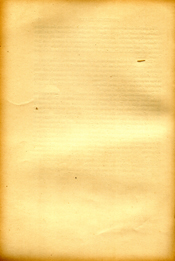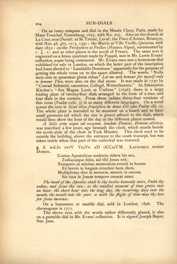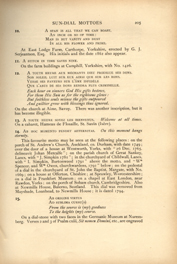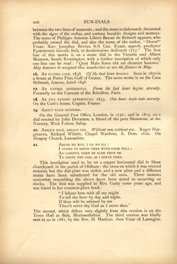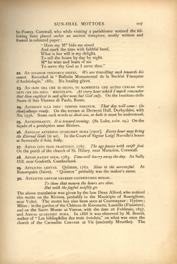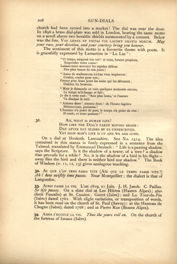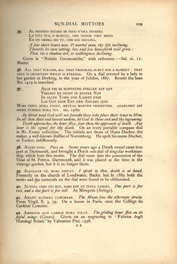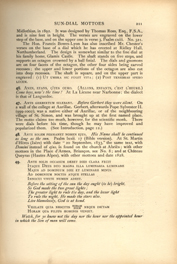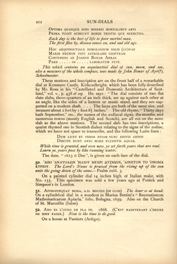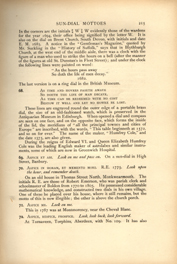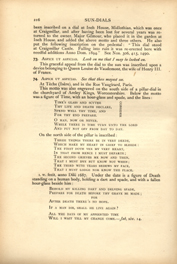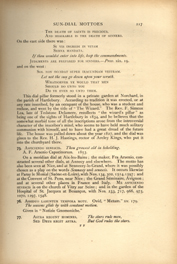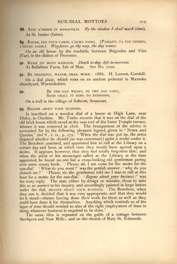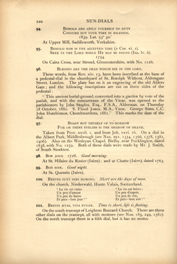SUN-DIAL MOTTOES
SUN-DIAL MOTTOES
| 1. |
A CLOCK THE TIME MAY WRONGLY TELL,Recorded in "Fen and Wold" as seen on a dial in the Fens. |
||||
| 2. | A DAY MAY RUIN THEE. IMPROVE THIS HOUR. A.D. MD CC XXX II. On the church porch, Seamer, Yorkshire. |
||||
| 3. | A DIEU SEUL HONNEUR ET GLOIRE. To God alone honour and glory. On the Café de la Gare, La Roche-de-Rame (Hautes Alpes). |
||||
| 4. | A LA BONNE HEURE. In God's good time. W. A. B. B. FAURE FECIT. 1724. At Villeneuve (Hautes Alpes). |
||||
| 5. | A LUMINE MOTUS. Moved by the light. Copied in 1870 from a dial at Sestri Ponente, near Genoa. |
||||
| 6. |
| ||||
| At Graglia, in Piedment. | |||||
| 7. | A SOLIS ORTU USQUE AD OCCASUM. From the rising up of the sun unto the going down of the same. On the cemetery wall at St. Gervais, Savoy; copied 1874. The motto (Psalm cxiii. 3), in a slightly different form, was once on the upper part of the Queen's Cross near Northampton, where there were four dials, facing the four points of the compass. On the east side were the words AB ORTV SOLIS, on the west VSQVE AD OCCASVM, on the south LAVDATVR DOMINVS, and on the north AMEN . MDCCXIII. The cross was erected by Edward I. in memory of his wife, Eleanor of Castile, and in 1713 it was repaired by order of the Justices of Northampton, and the dials and mottoes added; but in 1762 the latter were omitted when the faces of the dials were repainted, and the cross again repaired. The dials have since been removed. |
||||
| 8. | A SOLIS ORTU USQUE AD OCCASUM. LAUDIBILE NOMEN DOMINI. The Lord's Name is praised from the rising up of the sun unto the going down of the same (Psalm cxiii 3). |
On an ivory compass and dial in the Musée Cluny, Paris, made by Hans Troschel, Nuremberg, 1627, with No. 207. Also on the church at La Cour, near Durtal; at St. Trinité, Laval; the Place d' Armes, Briançon, with Nos. 48, 365, 1213, 1591; the Mairie at Ville Vieille, Queyras, with date 1852 ; on the Presbytère at Prelles (Hautes Alpes), surmounted by
and at other places in the south of France. The same text is engraved on a brass quadrant made by Poppel, now in Mr. Lewis Evans' collection, usque being contracted. Mr. Evans once saw a honestone dial exhibited for sale in London, on which the latter part of the inscription had been altered to "Laudabile Dominum," apparently for the purpose of getting the whole verse on to the space allowed. The words, "Nulla meis sine te quaeratur gloria rebus" Let me seek honour for myself only to honour Thee, were also on the dial stone. It was made in 1750 by "Conrad Schmeid, canonicus, Collegii, Wetterhausen." In Athanasius Kircher's "Ars Magna Lucis et Umbrae" (1646), there is a large folding plate of twenty-four dials arranged in the form of a tree, and four dials in the corners. From these radiate thirty-four versions of this verse (Psalm cxiii. 3) in as many different languages. On a scroll across the tree is Sicut oliva fructifera in domo Dei (See Psalm clii. 2). The whole plate is intended to be mounted on a board, and to have small gnomons (of which the size is given) affixed to the dials, which would then show the hour of the day at the different places named. A Solis ortu usque ad occasum, laudate Domine, Domine alleluia, was inscribed a few years ago beneath the clock, which stands beside the north aisle of the choir in York Minster. This clock used to be outside the building, above the entrance to the south transept, but was taken inside when that part of the cathedral was restored. |
||||||
| 9. | A SOLIS ORTV VSQVE AD OCCASVM. LAUDABILE NOMEN DOMINI. |
|||||
Coetus Apostolicus coelestia sidera bis sex, |
||||||
The band of the Apostles shall be thy twelve heavenly stars, Faith thy zodiac, and Jesus thy sun; as the smallest moment of time grows into an hour, the short hour into the long day, the recurring days into the month, the month into the year, so with the flight of time may thy love for Jesus increase. |
||||||
On a honestone or marble dial, sold in London, 1896. The chronogram is 1771. The above text, with the words rather differently placed, is also on a portable dial in Mr. Evans' collection. It is signed Joseph Bayer. Soc. Jesu. |
| 10. |
A SPAN IS ALL THAT WE CAN BOAST, At East Lodge Farm, Carthorpe, Yorkshire, erected by G. J. Serjeantson, Esq. His initials and the date 1862 also appear. |
| 11. | A STITCH IN TIME SAVES NINE. On the farm buildings at Camphill, Yorkshire, with No. 1426. |
| 12. |
A TOUTE HEURE AUX MÉCHANTS DIEU PRODIGUE SES DONS.
Each hour on sinners God His gifts bestows, On the church at Aime, Savoy. There was another inscription, but it has become illegible. |
| 13. | A TOUTE HEURE SOYEZ LES BIENVENUS. Welcome at all times. On a cabaret, Hameau de Flosaille, St. Savin (Isère). |
| 14. | AB HOC MOMENTO PENDET AETERNITAS On this moment hangs eternity. This favourite motto may be seen at the following places: on the porch of St. Andrew's Church, Auckland, co. Durham, with date 1749; over the door of a house at Wentworth, Yorks, with "26 Dec. 1765. delineavit Johan Metcalfe"; on the parish church of Great Sankey, Lancs, with "J. Simpkin 1781"; in the churchyard of Childwall, Lancs, with "I. Simpkin, Burtonwood 1791" above the motto, and "Wm Spencer, and Wm Owen, churchwardens, 1791" below; on the pedestal of a dial in the churchyard of St. John the Baptist, Margate, with No. 1669; on a house at Offerton, Cheshire; at Sprawley, Worcestershire; on a dial in Frankfort Museum; on a chapel at East London, near Rawdon, Yorks; on the porch of Soham church, Cambridgeshire. Also at Newmills House, Balerno, Scotland. This dial was removed from Mayshade, Loanhead, to Newmills House; it is dated. 1794. |
| 15. | AB ORIGINE VIRTUS On a dial-stone with two faces in the Germanic Museum at Nuremberg. Verses 2 and 3 of Psalm cxiii, Sit nomen Domini, etc., are engraved |
between the two lines of the numerals; and the stone is elaborately decorated with the signs of the zodiac, and various heraldic designs and mottoes. The name of Philippo Antonio Libero Baroni de Reinach appears, who probably owned the dial, and also the name of the maker, "Devotmo Franc: Xav: Josephus Bovius, S.S, Can. Exam. approb. presbyter Eystettensis invenit, fecit, et demississime dedicavit 1717." The first line of this motto is on a stone dial in the Victoria and Albert Museum, South Kensington, with a further inscription of which only one line can be read: "Quot Maio flores tibi tot dicantur honores." May honours be assigned thee, numberless as are the flowers in May. |
|
| 16. | AB ULTIMA CAVE, 1838. Of the last hour beware. Seen in 1870 in a house at Porto Fino, Gulf of Genoa. The same motto is on the Casa Beltrami, Ameno, dated 1846. |
| 17. | AB ULTIMA AETERNITAS. From the last hour begins eternity. Formerly on the Convent of the Récollets, Paris. |
| 18. | AB UNA PENDET AETERNITAS, 1833. One hour leads into eternity. On the Curé's house, Cognin, France. |
| 19. | ABOUT YOUR BUSINESS. On the General Post Office, London, in 1756; and in 1815, on a dial erected by John Devaston, a friend of the poet Shenstone, at the Nursery, West Felton, Salop. |
| 20. | ABSQUE SOLE, ABSQUE USU. Without sun, without use. Roger Hargreaves, Richard Whittle, Chapel Wardens, A. Dom. 1826. On Heapey Church, Lancashire. |
| 21. |
ABUSE ME NOT, I DO NO ILL: This inscription used to be on a copper horizontal dial in Shaw churchyard, in the parish of Oldham; the cross on which it was erected remains, but the dial-plate was stolen, and a new plate and a different motto have been substituted for the old ones. Three mottoes somewhat resembling the above have been noted as occcurring on clocks. The first was supplied to Mrs. Gatty some years ago, and was found in her common-place book: "I labour here with all my might The second, which differs very slightly from this version, is on the Town Hall at Bala, Merionethshire. The third version was kindly sent to us in 1881, by the Rev. H. Maclean, then Vicar of Lanteglos- |
by-Fowey, Cornwall, who while visiting a parishioner noticed the following lines placed under an ancient timepiece, neatly written and framed in coloured paper: "Here my Mrs bids me stand |
|
| 22. | AD OCCASUM TENDIMUS OMNES. We are travelling each towards his sunset. Recorded in "Bulletin Monumental de la Société Française d'Archéologie," 1881, No locality given. |
| 23. | AD OGNI ORA CHE IO SEGNO, TU RAMMENTA CHE ALTRO CERCAR NON DEVI CHE DIO SOLO. MDCCCLXVI. At every hour which I mark remember that thou oughtest to seek after none but God only. On the Instituto delle Suore di San Vicenzo di Paolo, Rome. |
| 24. | ADVENIET ILLA DIES : SEMPER PARATUM. That day will come: (be thou) always ready. On the terrace at Derwent Hall, Derbyshire, with No. 1536. Some such words as decet esse, or habe te must be understood. |
| 25. | ADVESPERASCIT. It is toward evening. (St. Luke, xxiv. 29.) On the façade of a presbytère near Béziers. |
| 26. | ADVOCAT AETERNOS QUAELIBET HORA [DEOS]. Every hour may bring the Eternal Gods [to us]. In the Court of Signor Luigi Novello's house at Serravalle d'Asti, Italy. |
| 27. | AETAS CITO PEDE PRAETERIT, 1787. The age passes with swift foot. On the porch of the church at St. Hilary, near Marazion, Cornwall. |
| 28. | AETAS RAPIET DIEM, 1783. Time will hurry away the day. At Sally Hill, near Gosforth, Cumberland. |
| 29. | AFFLICTIS LENTAE. Quinton, 1762. Slow to the sorrowful. At Beaurepaire (Isère). "Quinton" probably was the maker's name. |
| 30. | AFFLICTIS LENTAE CELERES GAUDENTIBUS HORAE.
To them that mourn the hours are slow, The above translation was given by the late Dean Alford, who noticed this motto on the Riviera, probably in the Municipio of Rossiglione, near Voltri. The motto has also been seen at Courmayeur: Hyères; Milan; in the garden of the Château de Kerouartz, Lannilis (Finistère); and on the Sacro Monte at Varese, with the date 26 Febbraio, 1857, and AMICIS QUAELIBET HORA. In 1888 it was observed by M. Benoit, author of "Les bibliophiles des trios évêchés," on what was once the church of the Carmelite Convent at Vic (anciently Meurthe). The |
church had been turned into a market! The dial was near the door. In 1896 a brass dial-plate was sold in London, bearing the same motto on a scroll above two heraldic shields surmounted by a coronet. Below was the line, VOS GENUS ET PIETAS VOS LAUDET GRATIA MORUM. May your race, your devotion, and your courtesy bring you honour. The sentiment of this motto is a favourite theme with poets. It is gracefully expressed by Lamartine in "Le Lac":
"O temps, suspend ton vol! et vous, heures propices,
"Assez de malheureux ici-bas vous implorent:
"Mais je demande en vain quelques moments encore,
"Aimons donc! aimons donc! de l'heure fugitive |
|
| 31. |
AH, WHAT IS HUMAN LIFE! On a dial at Hesketh, Lancashire. See No. 1414. The idea contained in this stanza is finely expressed in a sentence from the Talmud, translated by Emmanuel Deutsch: "Life is a passing shadow, says the Scripture. Is it the shadow of a tower, of a tree? a shadow that prevails for a while? No, it is the shadow of a bird in his flight – away flies the bird and there is neither bird nor shadow." The Book of Wisdom (v. 11, 12, 13) gives analogous teaching. |
| 32. | AI QUE L'ON TENS PASSA VITE. [AÏE QUE LE TEMPS PASSE VITE!] Ah! How swiftly time passes. Near Montpellier; the dialect is that of Languedoc. |
| 33. | AINSI PASSE LA VIE. L'an 1819, 21 Juin. J. H. Jacob. C. Paillas. So life passes. On a slate dial at Les Hières (Hautes Alpes); also (fecit Pascalis) at St. Cassien; Gavet (Isère); and La Tour-de-Pin (Isère) dated 1762. With slight variations, or transposition of words, it has been read on the church of St. Paul (Savoy); at the Hameau de Chogne (Isère), dated 1768; and at Pierre Rue (Basses Alpes). |
| 34. | AINSI S'ÉCOULE LA VIE. Thus the years roll on. On the church of the fortress of Izeaux (Isère). |
| 35. |
AL PROPRIO OCCASO IN POCO D'ORA INCHINA
A few short hours now, O mortal man, they life inclining, Given in "Notizie Gnomoniche," with reference; – Sal. ci. 12; Mattei. |
| 36. | ALL THAT PLEASES, ALL THAT TROUBLES, IS BUT FOR A MOMENT: THAT ONLY IS IMPORTANT WHICH IS ETERNAL. On a dial erected by a lady in her garden at Dorking, in the year of Jubilee, 1887. Round the base No. 1419 is inscribed. |
| 37. |
ALLE DIE IR HOFFNUNG STELLEN AUF GOT MORS VENIT, HORA FUGIT, METUAS MORTEM VENIENTEM. QUAELIBET EST INDEX FUNERIS HORA TUI. HD. 1560. In direst need God will not forsake those who place their trust in Him. In all thou doest and leavest undone, let God be thine end and thy beginning. Death approaches, the hour flies, fear thou the approach of death. Any hour is the signal for thy death. On an ivory portable compass dial in Mr. Evan's collection. The initials are those of Hans Ducher, the maker, a well-known diallist of Nuremberg. He spelt his name Ducher, or Tucher, indifferently. |
| 38. | ALLEZ VOUS. Pass On. Some years ago a Dutch vessel came into port at Darmouth, and brought a Dutch sun-dial of singular workmanship, which bore this motto. The dial came into the possession of the Vicar of St. Petrox, Dartmouth, and it was placed at the time in the vicarage garden, but it is no longer there. |
| 39. | ALLOQUAR TE, MORS INSTAT. I speak to thee, death is at hand. Formerly on the church of Loudwater, Bucks, but in 1889 both the motto and the numerals on the dial were found to be obliterated. |
| 40. | ALTERA PARS OTI EST, PARS EST ET JUSTA LABORI. One part is for rest, and a due part is for toil. At Mirepoix (Ariège). |
| 41. | AMANT ALTERNA CAMOENAE. The Muses love the alternate strain. From Virgil, E. 3, 59. On a house in Paris, once the Collège du Cardinal Lemoine. |
| 42. | AMBIGUIS ALIS LABILIS HORA VOLAT. The gliding hour flies on its fitful wings (Cicero). Given on an engraving in "Fabrica degli Horologi Solari," by Valentino Pini, 1598. |
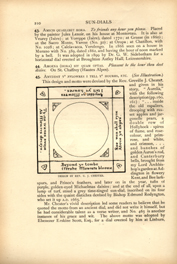
[Full Image]
DESIGN BY REV. G. J. CHESTER.
| 43. | AMICIS QUAELIBET HORA. To friends any hour you please. Placed by the painter Jules Lenoir, on his house at Montereau. It is also at Veurey (Isère); at Voreppe (Isère), dated 1770; at Grasse (in 1860); at the Sacro Monte, Varese (No. 30); at Oropa; at Chatillon, with No. 1028; at Calciavacca, Verolengo. In 1866 seen on a house in Murano with No. 589, dated 1862, and having the hour of noon marked by a bell. It was adopted in 1899 by Dr. G. W. Sidebotham for a horizontal dial erected at Broughton Astley Hall, Leicestershire. |
| 44. | AMOENA (HORA) SIT QUAM OPTAS. Pleasant be the hour thou dost desire. On St. Chaffrey (Hautes Alpes). |
| 45. | AMYDDST YE FFLOWRES I TELL YE HOURES, ETC. (See Illustration.) This design and motto were devised by the Rev. Greville J. Chester, and given in his story, "Aurelia," with the following description (pp. 160, 161): ". . . inside the old espaliers, drooping with russet apples and jargonelle pears, a double row of Hollyhock-spires of flame, and rose-colour, and primrose, and white, and crimson, . . . and bunches of golden Aaron's rod, and Canterbury bells, brought from my Lord Archbishop's garden at Addington in flowery Kent, and Bee larkspurs and Prince's feathers, and later on in the year, tufts of purple, golden-eyed Michaelmas daisies; and at the end of all, upon a lump of turf, stood a grey time-tinged sun-dial, inscribed on its four sides with the quaint distiches devised by Bishop Edmund Redyngton, who set it up A.D. 1665." Mr. Chester's vivid description led some readers to believe that he quoted the motto from an ancient dial, and did not write it himself, but he had considerable talent as a verse writer, and No. 465 is another instance of his grace and wit. The above motto was adopted by Ebenezer Erskine Scott, Esq., for a dial erected by him at Linburn, |
| 45. (cont.) | Midlothian, in 1892. It was designed by Thomas Ross, Esq., F.S.A., and is nine feet in height. The verses are engraved on the lower step of the base, and on the upper one is verse 3, Psalm cxiii. No. 321. The Hon. Francis Bowes-Lyon has also inscribed Mr. Chester's verses on the base of a dial which he has erected at Ridley Hall, Northumberland. The design is somewhat similar to the fine dial at his family home, Glamis Castle. The shaft stands on five steps, and supports an octagon crowned by a ball finial. The dials and gnomons are on four facets of the octagon, the other four sides being carved recesses; the upper and lower portions of the octagon are also cut into deep recesses. The shaft is square, and on the upper part is engraved: (1) UT UMBRA SIC FUGIT VITA; (2) POST TENEBRAS SPERO LUCEM. |
||||||||||||
| 46. | ANEN, EFANS, Q'UES OURO. (ALLONS, ENFANTS, C'EST L'HEURE.) Come boys, now's the time! At La Licune near Narbonne; the dialect is that of Languedoc. | ||||||||||||
| 47. | ANTE GERBERTUM SILEBANT. Before Gerbert they were silent. On a wall of the college at Aurillac. Gerbert, afterwards Pope Sylvester II. (999-1002), was a native either of Aurillac, or of the neighbouring village of St. Simon, and was brought up at the first named place. The motto claims too much, however, for the scientific monk. There were dials before his time, though he may have improved and popularized them. (See Introduction, page 12.) | ||||||||||||
| 48. | ANTE SOLEM PERMANET NOMEN EJUS. His Name shall be continued as long as the sun. Psalm lxxii. 17 (Bible version). At St. Martin d'Hères (Isère) with date "20 Septembre, 1833," the same text, with Domini instead of ejus, is found on the church at Abriès; with other mottoes in the Place d'Armes, Briançon, see No. 8; and at Château Queyras (Hautes Alpes), with other mottoes and date 1828. | ||||||||||||
| 49. |
ANTE SOLIS OCCASUM DEBET DIES CLARA FECIT
Before the setting of the sun the day ought (to be) bright,
Watch, for ye know not the day nor the hour nor the appointed hour in which the Son of man will come. |
OPTIMA QUAEQUE DIES MISERIS MORTALIBUS AEVI
Each day is the best of life to poor mortal man,
HOC AEQUINOCTIALE HOROLOGIUM SOLIS (LU)NAE This which contains an aequinoctial dial of sun, moon, and sea, also a measure of the whole compass, was made by John Bonar of Ayr(?), Schoolmaster. These mottoes and inscription are on the front half of a remarkable dial at Kenmure Castle, Kirkcudbright, which has been fully described by Mr. Ross in his "Castellated and Domestic Architecture of Scotland," vol. v., p. 438 et seq. He says: "The dial consists of two flat slate slabs, three-quarters of an inch thick, set up against each other at an angle, like the sides of a lectern or music stand, and they are supported on a modern shaft. . . . The faces are both of the same size, and measure about 2 feet by 1 foot 8 ½ inches." The old rhyme, "Thirty days hath September," etc., the names of the zodiacal signs, the months, and numerous towns (mostly English and Scotch), are all cut on the same slab as the above mottoes. The second slab has two inscriptions, a quaint rhymed one in Scottish dialect relating to the signs of the zodiac, which we have not space to transcribe, and the following Latin lines:
DUM LICET ET VEROS ETIAM NUNC EDITIS ANNOS While time is granted, and even now, ye set forth years that are real. Learn ye, years pass by like running water. The date, "1623 II Dec", is given on each face of the dial. |
|
| 50. | 'AΠO 'ANATOΛΩN 'HΛIOϒ MEXPI ΔϒΣMΩN, 'AINETON TO 'ONOMA KϒPIOϒ. The Lord's Name is praised from the rising up of the sun unto the going down of the same. – Psalm cxiii. 3. On a painted cylinder dial 14 inches high, of Italian make, with No. 155. This specimen was sold a few years ago at Puttick and Simpson's in London. |
| 51. | APPROPINQUAT HORA, A. D. MDCIIII (OR CLIII) The hour is at hand. On a cylindrical dial in a woodcut in Marius Bettini's "Recreationum Mathematicarum Apiaria," folio, Bologna, 1659. Also on the Church of St. Marcellin (Isère). |
| 52. | ARO ES L'OURO DE PLA FE. 1868. (C'EST MAINTENANT L'HEURE DE BIEN FAIRE.) Now is the time to do good. On a house at Pamiers (Ariège). |
| 53. | ARO ES L'LOURO DEL TRIBAL. (C'EST MAINTENANT L'HEURE DE LA TRAVAIL.) Now is the time to work. Read at Castelnaudrary. This, and the motto above, are in the dialect of Languedoc. |
| 54. |
ARRESTE ICI, PASSANT, PENSE À TA FIN DERNIÈRE,
Pause in life's journey, give to Death one thought; At La Fontenil sous Briançon. There are two dates on the dial, 1831 and 1883, the latter being that of its restoration. The same motto in a slightly different form is on the church at St. Chaffrey, (Hautes Alpes); and at Le Monêtier-les- Bains, dated 1865. |
| 55. | ARRESTO TI PASSANT REGARDO QUANTES D'OURO, ET FOUTO MI LOU CAMP. (ARRÈTE TOI, PASSANT, REGARDE QUEL HEURE IL EST, ET FOUTEZ MOI LE CAMP.) Stop a moment, wayfarer, look what time it is, and then be off! In the dialect of Provence, seen near Aix. |
| 56. |
ARRIPE HORAM, ULTIMAMQUE TIMEAS. 8BRE 1812 On a meridian dial at Tours. |
| 57. | ARS LONGA VITA BREVIS. Art is long, life is short. At Ballafreer Farm, Braddan, Isle of Man, see No. 1020. The dial was made by John Kewley. |
| 58. | ARTE MIRA MORTALIUM TEMPERAT HORAS. With wondrous skill he regulates the hours of men's lives. On a house belonging to the Grand Séminaire at Fréjus; also at Villeneuve, Val d'Aosta. |
| 59. | A RING IS ROUND AND HATH NO END This posy is on a ring dial in the British Museum, probably the same one that was exhibited by the Society of Antiquaries, 1884, and described in their Proceedings, vol. xi., No. 1. |
| 60. | AS A SHADOW, SUCH IS LIFE. Lat. 52° 20' 1848. Over the porch entrance of Wensley Church, Yorkshire. |
| 61. | AS A SERVANT EARNESTLY DESIRETH THE SHADOW. These words from Job, vii. 2, with eight other mottoes, were on a dial pillar, called Prince Albert Victor's Dial, shown in the Edinburgh Exhibition, 1886. See No. 1306. |
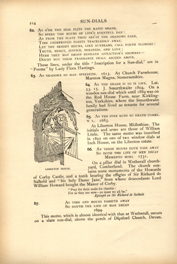
[Full Image]
LIBERTON HOUSE.
| 62. |
AS O'ER THE DIAL FLITS THE RAPID SHADE, These lines, under the title "Inscription for a Sun-dial," are in "Poems" by Lady Flora Hastings. |
||
| 63. | AS SHADOWE SO MAN SPEEDETH. 1613. At Church Farmhouse, Marston Magna, Somersetshire. | ||
| 64. | AS THE SHADE IS SO IS LIFE. Lat. 53. 15. J. Smurthwaite 1804. On a wooden sun-dial which until 1889 was on the Red House Farm, near Kirklington, Yorkshire, where the Smurthwaite family had lived as tenants for several generations. |
||
| 65. | AS THE SVNE RUNS SO DEATH COMES. W L. 1683. At Liberton House, Midlothian. The initials and arms are those of William Little. The same motto was inscribed in 1892 on one of two window dials at Inch House, on the Liberton estate. |
||
| 66. | AS THESE HOURS DOTH PASS AWAY On a pillar dial in Wetherall churchyard, Cumberland. The church contains some monuments of the Howards of Corby Castle, and a tomb bearing the effigies of Sir Richard de Salkeld and "his lady Dame Jane," from whose descendants Lord William Howard bought the Manor of Corby.
|
||
| 67. | AS TIME AND HOURS PASSETH AWAY This motto, which is almost identical with that at Wetherall, occurs on a slate sun-dial, above the porch of Diptford Church, Devon. |
In the corners are the initials
"As the hours pass away The last version is on a ring dial in the British Museum. |
|||||
| 68. | AS TIME AND HOVRES PASETH AWAYE These lines are engraved round the outer edge of a portable brass dial, the size of an old-fashioned watch, which is preserved in the Antiquarian Museum in Edinburgh. When opened a dial and compass are seen on one face, and on the opposite face, which forms the inside of the lid, the meridians of "all the principal townes and cities of Europe" are inscribed, with the words, "This table beginneth at 1572, and so on for ever." The name of the maker, "Humfrey Cole," and the date 1575, are also given. During the reigns of Edward VI. and Queen Elizabeth Humfrey Cole was the leading English maker of astrolabes and similar instruments, some of which are now in Greenwich Hospital. |
||||
| 69. | ASPICE ET ABI. Look on me and pass on. On a sun-dial in High Street, Banbury. | ||||
| 70. | ASPICE IN HORAM, ET MEMENTO MORI. R. E. 1775. Look upon the the hour, and remember death. On an old house in Thomas Street North, Monkwearmouth. The initials R. E. are those of Robert Emerson, who was parish clerk and schoolmaster of Boldon from 1770 to 1805. He possessed considerable mathematical knowledge, and constructed two dials in his own village. One of these he placed over his house, where it still remains, but the motto of this is now illegible; the other is above the church porch. |
||||
| 71. |
ASPICE ME. Look on me. This in 1787 was at Montmorency, near the Cheval Blanc. |
||||
| 72. | ASPICE, RESPICE, PROSPICE. Look, look back, look forward. At Tornaveen, Torphins, Aberdeen, with No. 109. It has also |
been inscribed on a dial at Inch House, Midlothian, which was once at Craigmillar, and after having been lost for several years was returned to the owner, Major Gilmour, who placed it in the garden at Inch House, and added the above motto and three others. He also put the following inscription on the pedestal: "This dial stood at Craigmillar Castle. Falling into ruin it was re-erected here with needful additions Anno Dom. 1894." See Nos. 306, 415, 1490. |
||||||
| 73. | ASPICE UT ASPICIAR. Look on me that I may be looked on. This graceful appeal from the dial to the sun was inscribed upon a device belonging to Queen Louise de Vaudemont, the wife of Henry III. of France. |
|||||
| 74. | ASPICE UT ASPICIAS. See that thou mayest see. At Tèche (Isère), and in the Rue Vaugirard, Paris. This motto was also engraved on the south side of a pillar-dial in the churchyard of Areley Kings, Worcestershire. Below the motto was a figure of Time, with an hour-glass and spade, and the lines:
On the north side of the pillar is inscribed: THREE THINGS THERE BE IN VERY DEEDE, I. W. fecit, anno Dmi 1687. Under the date is a figure of Death standing on a human body, holding a dart and spade, and with a fallen hour-glass beside him:
|
On the east side there was:
and on the west:
This dial pillar formerly stood in a private garden at Norchard, in the parish of Hartlebury. According to tradition it was erected, or at any rate inscribed, by an occupant of the house, who was a student and recluse, and went by the title of "The Wizard." The Rev. F. Simcox Lea, late of Tedstone Delamere, recollects "the wizard's pillar" as being one of the sights of Hartlebury in 1834, and he believes that the somewhat morbid tone of all the inscriptions arose from the introversial character of the inscriber's mind, who seems to have held much solitary communion with himself, and to have had a great dread of the future life. The house was pulled down about the year 1827, and the dial was given to the Rev. H.J. Hastings, rector of Areley Kings, who put it into the churchyard there. |
|||||
| 75. |
ASIPICIENDO SENESCIS. Thou growest old in beholding. On a meridian dial at Aix-les-Bains; the maker, Fra Arsenio, constructed several other dials, at Annecy and elsewhere. The motto has also been seen at Nice, and at Sennecey-le-Grand, where it was possibly chosen as a play on the words Sennecey and senescis. It occurs likewise at Paray le Monial (Saône-et-Loire), with Nos. 134, 302, 1514, 1597; and at the Convent of St. Pens, near Nice; the Grand Séminaire, Avignon; and at several other places in France and Italy. ME ASPICIENDO SENESCIS is on the church of Vitry sur Seine; and in the garden of the Hospital of St. Jacques at Besançon, with Nos. 233, 717, 966, 975, 1070, 1297, 1548. |
||||
| 76. |
ASSIDUO LABUNTUR TEMPORA MOTU. Ovid, "Metam." xv. 179. Given in "Notizie Gnomoniche." |
||||
| 77. |
|
On the belfry of St. Germain la Blanch Herbe, near Caen, with No. 1484. |
|
| 78. | AUJOURD'HUI À MOI, DEMAIN À TOI. To-day is mine, to-morrow thine. On church of St. Véran (Isère); and in the cemetery at Courmayeur. |
| 79. | AUGET FIDEM CONCORDIA. Concord increases faith. Formerly on the Séminaire de St. Sulpice, Paris. |
| 80. | AURORA HORA AUREA. Dawn the golden hour. Engraved on the gnomon of an old pedestal dial which once stood on the lawn at Mountains, near Hildenborough, Kent. |
| 81. | AUT DISCE, AUT DISCEDE. Either learn or go. On a dial at the Royal Military Academy, Woolwich. The same motto, with the addition, MANET SORS TERTIA CAEDI, A third choice remains, to be flogged, is preserved on a tablet at the end of the schoolroom of Winchester College, being characteristic of the hardy discipline of that ancient public school. |
| 82. | AUT LAUDA VEL EMENDA. 1738. R. Nellson, Fecit. Either commend, or amend. The note respecting this dial has been imperfectly filled up, and the collector has lost all recollection of the locality. Its application is dubious, but possibly the same as No. 182. |
| 83. | AUT MERCES AUT POENA MANET QUAS VIVIMUS HORAS. Reward or punishment awaits the hours of our life. On the Hôtel de Ville, Mende. |
| 84. | AUTANT BOIRE ICI QU'AILLEURS. As well drink here as elsewhere. On an inn at St. Didier de la Tour (Isère); and at Vasselin (Isère). |
| 85. |
AUTREFOIS NOUS COMPTIONS LES HEURES COMME VOUS,
In life like you we marked the passing hours, On a mausoleum in the cemetery at Rabastens d'Albigeois. A clock dial is engraved above. |
| 86. | AVANT DE REGARDER SI JE SUIS JUSTE, REGARDE SI TU L'EST TOI MÊME. Before thou lookest if I am right, look if thou are right thyself. At Laon. |
| 87. | AVE MARIA DÑI MEI MATER. Hail, Mary, Mother of my Lord. On a dial dated 1881, within the church of Harcourt (Eure) |
| 88. | AVEC L'OMBRE JE MARQUERAI. By the shadow I shall mark (time). At St. Ismier (Isère). |
| 89. | BADAN, FAR TOUN CAMIN, L'OURO PASSO. (PASSANT, VA TON CHEMIN, L'HEURE PASSE.) Wayfarer, go thy way, the day wanes. On an old house by the roadside, between Brignoles and Vins (Var), in the dialect of Provence. |
| 90. | BAASE JIU BIOYS MAIRAGH. Death to-day, life to-morrow. At Ballafreer Farm, Isle of Man. See No. 1020. |
| 91. | BE THANKFUL, WATCH, PRAY, WORK. 1886. H. Leeson, Cornhill. On a dial plate, which rests on an ancient pedestal in Maxtoke churchyard, Warwickshire. |
| 92. | BE THE DAY WEARY, BE THE DAY LONG, On a wall in the village of Ashcott, Somerset. |
| 93. | BEGONE ABOUT YOUR BUSINESS. Is inscribed on a wooden dial of a house at High Lane, near Disley, in Cheshire. Mr. Timbs records that it was on the dial of the old brick house which stood at the east end of the Inner Temple terrace, whence it was removed in 1828. The brusqueness of the advice is accounted for by the following pleasant legend, given in "Notes and Queries," 2nd S, v. ix., p. 279: "When the dial was put up, the artist inquired whether he should (as was customary) paint a motto under it. The Benchers assented, and appointed him to call at the Library on a certain day and hour, at which time they would have agreed upon a motto. It appears, however, that they had totally forgotten this; and when the artist or his messenger called at the Library at the time appointed, he found no one but a cross-looking old gentleman poring over some musty book. 'Please, sir, I am come for the motto for the sun-dial. 'What do you want?' was the pettish answer: 'why do you disturb me?' 'Please, sir, the gentleman told me I was to call at this hour for a motto for the sun-dial.' 'Begone about your business!' was the testy reply. The man, either by design or mistake, chose to take this as an answer to his inquiry, and accordingly painted in large letters under the dial, BEGONE ABOUT YOUR BUSINESS. The Benchers, when they saw it, decided that it was very appropriate, and that they would let it stand – chance having done their work for them as well as they could have done it for themselves. Anything which reminds us of the lapse of time should remind us also of the right employment of time in doing whatever business is required to be done." The same idea is repeated on the gable of a cottage between Stockport and New Mills; and on the church of Bury St. Edmunds. |
| 94. | BEHOLD AND APPLY YOURSELF TO DUTY At Upper Mill, Saddleworth, Yorkshire. |
||
| 95. |
BEHOLD NOW IS THE ACCEPTED TIME (2 Cor. vi. 2). On Cains Cross, near Stroud, Gloucestershire, with No. 1126. |
||
| 96. | BLESSED ARE THE DEAD WHICH DIE IN THE LORD. These words, from Rev. xiv. 13, have been inscribed at the base of a pedestal-dial in the churchyard of St. Botolph Without, Aldersgate Street, London. The plate has on it an engraving of the old Alders Gate; and the following inscriptions are cut on three sides of the pedestal: "This ancient burial-ground, converted into a garden by vote of the parish, and with the concurrence of the Vicar, was opened to the parishioners by John Staples, Esq., F.S.A., Alderman, on Thursday 28 October, 1880. S. Flood Jones, M.A., Vicar. George Sims, C.C. John Hutchinson, Churchwardens, 1881." This marks the date of the dial. |
||
| 97. | BOAST NOT THYSELF OF TO-MORROW Taken from Prov. xxvii. 1, and from Job, xxvi. 16. On a dial in the Albert Park, Middlesbrough (see Nos. 291, 1334, 1366, 1378, 1381, 1406). Also on the Wesleyan Chapel. Bielby, near Pocklington, dated 1838, with No. 1259. Both of these dials were made by Mr. J. Smith, of South Stockton. |
||
| 98. | BON JOUR 1728. Good morning. At. St. Hilaire de Rosier (Isère); and at Chatte (Isère), dated 1763. |
||
| 99. | BON SOIR. Good night. At St. Quentin (Isère). |
||
| 100. | BREVES SUNT DIES HOMINIS. Short are the days of man. On the church, Niederwald, Haute Valais, Switzerland.
|
||
| 101. | BREVIS ÆTAS, VITA FUGAX. Time is short, life is fleeting. On the south transept of Leighton Buzzard Church. There are three other dials on the transept, all with mottoes (see Nos. 185, 249, 1582). On the north transept there is a fifth dial, but it has no motto. |

